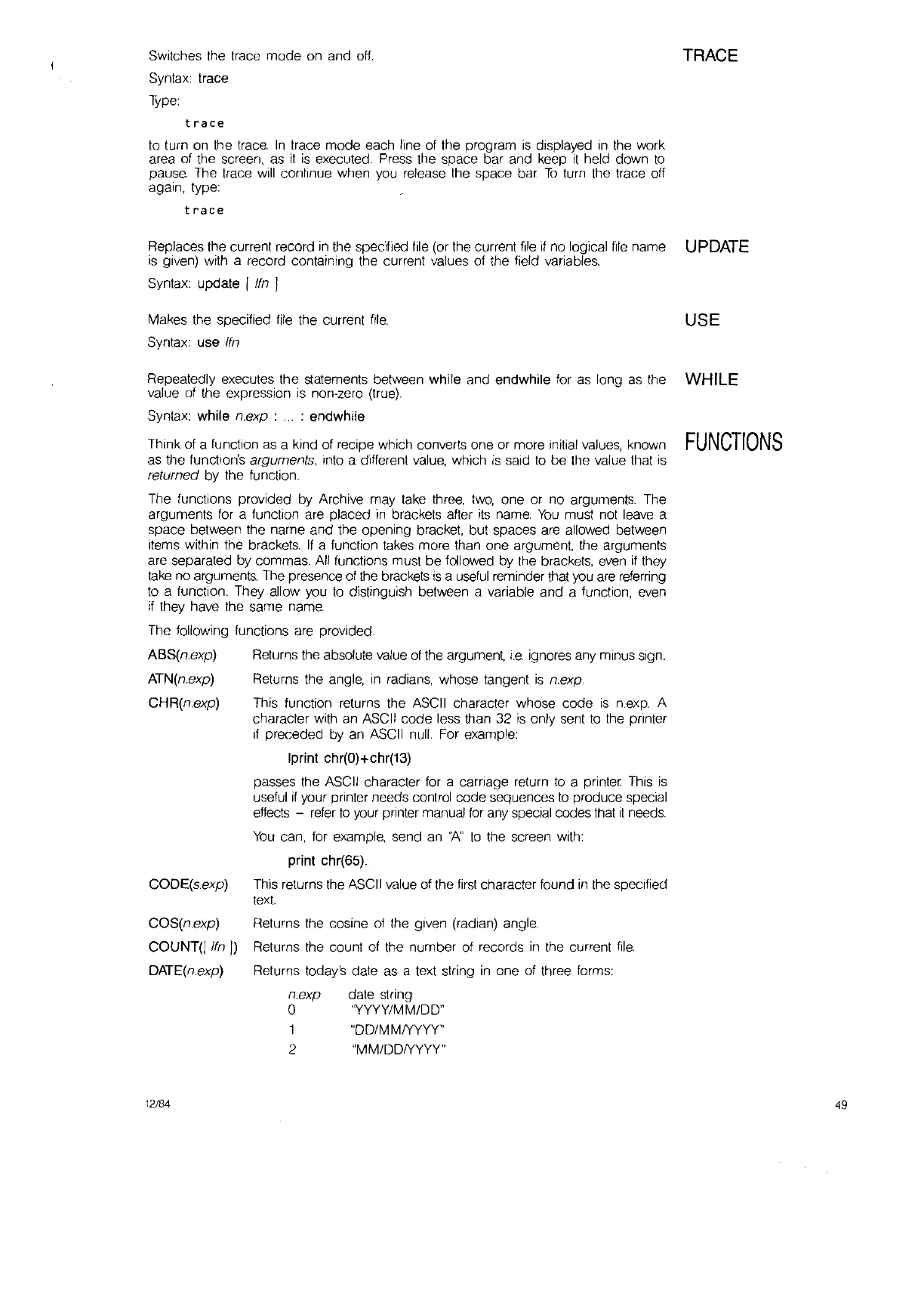Switches the trace mode on and
off.
Syntax: trace
Type:
trace
to
turn
on
the
trace.
In
trace mode each line
of
the program
is
displayed
in
the work
area
of
the screen,
as
it
is
executed. Press the space bar and keep
it
held down
to
pause.
The
trace
will
continue when
you
release the space
bar.
To
turn the trace off
again, type:
trace
TRACE
Replaces the current record
in
the spedfied
file
(or
the current
file
if no logical
file
name UPDATE
is
given) with a record containing the current values
of
the field variables.
Syntax: update
I lin ]
Makes the specified
file
the current
file.
USE
Syntax: use lin
Repeatedly executes the statements between while and endwhile for
as
long
as
the WHILE
value
of
the expression
is
non-zero (true).
Syntax: while
nexp:
: endwhile
Think
of
a function
as
a kind
of
recipe which converts one or more initial
values,
known
FUNCTIONS
as the function's arguments, into a different
value,
which
is
said
to
be the value that
is
returned by the function.
The functions provided by Archive may
take
three,
two,
one or no arguments. The
arguments
for
a function are placed
in
brackets after
its
name.
You
must
not
leave
a
space between the name and the opening
bracket, but spaces
are
allowed between
items within the brackets.
If
a function
takes
more than one argument, the arguments
are separated by commas. All functions must be
followed by the brackets, even if they
take
no arguments.
The
presence
of
the brackets
is
a
useful
reminder
that
you
are
referring
to
a function. They allow you
to
distinguish between a variable and a function, even
if they have the same
name.
The following functions
are
provided.
ABS(nexp)
ATN(n.exp)
CHR(nexp)
CODE(s.exp)
COS(nexp)
COUNT([lln
J)
DATE(nexp)
Returns the absolute
value
of
the argument,
i.e.
ignores
any
minus sign.
Returns the angle,
in
radians, whose tangent
is
nexp.
This function returns the
ASCII
character whose code
is
nexp. A
character with
an
ASCII code less than 32
is
only sent
to
the printer
If
preceded by
an
ASCII
null.
For
example:
Iprint chr(O)+chr(13)
passes the ASClf character
for
a carnage return
to
a printer
ThiS
is
useful
if
your printer needs control code sequences
to
produce special
effects
-
refer
to
your printer manual
for
any
special codes
that
it
needs.
You
can, for example, send
an
':4"
to
the screen with:
print chr(65).
This returns the
ASCII
value
of
the
first
character found
in
the specified
text.
Returns the cosine
of
the given (radian) angle.
Returns the count
of
the number
of
records
in
the current file
Returns today's date
as
a
text
string
in
one
of
three forms:
12/84
n.exp
o
1
2
date string
'YYYY/MM/DD"
"DD/MMIYYYY"
"MM/DDIYYYY"
49
